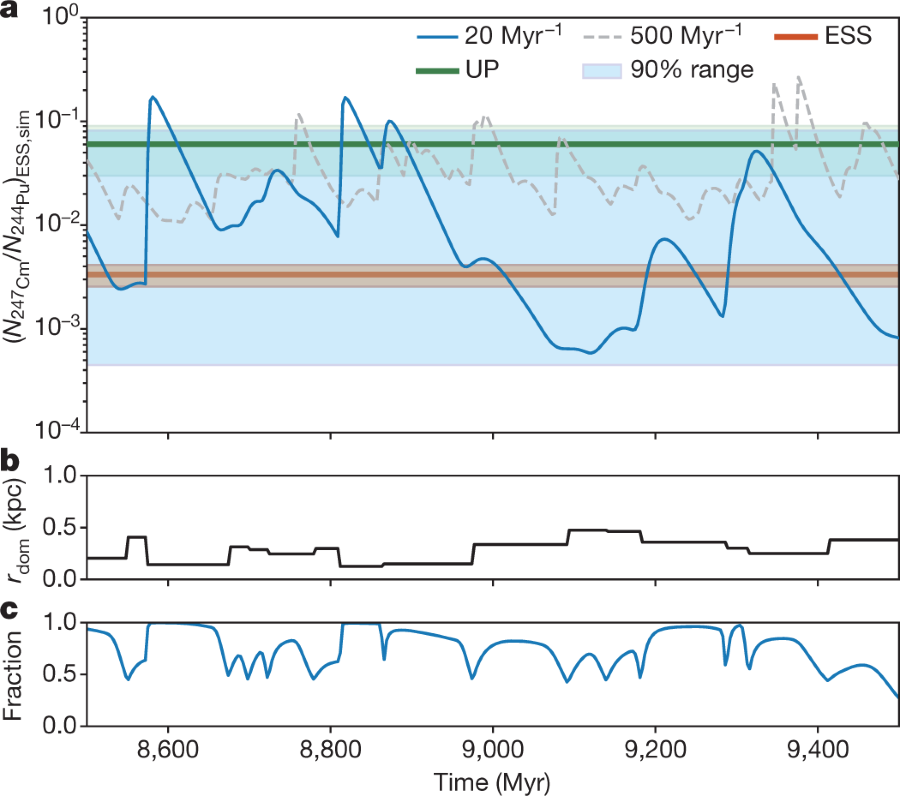NNadir
NNadir's JournalOh wow! 414.81 ppm of carbon dioxide recorded at Mauna Loa yesterday, down slightly from...
...Wednesday.
I don't keep records of daily readings; I'm limited to weeks, months and years in my files, but I'd guess this one is up there.
From Recent Daily Average Mauna Loa CO2
May 03: 414.81 ppm
May 02: Unavailable
May 01: 414.88 ppm
April 30: 414.52 ppm
April 29: Unavailable
Last Updated: May 4, 2019
Don't worry though. Be happy. I've been reading all the time, year after year, decade after decade, that so called "renewable energy" is exponentially growing exponentially on top of exponentially.
Actinides in the Solar System Probably Were Formed by a Neutron Star Collision.
The paper I'll discuss in this brief post is this one: A nearby neutron-star merger explains the actinide abundances in the early Solar System (Imre Bartos & Szabolcs Marka, Nature 569, 85–88 (2019) )
Although only two actinide elements occur naturally on Earth in significant quantities, thorium and uranium, it is well known from the examination of meteorites that the early solar system contained both plutonium and curium isotopes and their decay daughters. (cf. Origin of uranium isotope variations in early solar nebula condensates. (Cf Origin of uranium isotope variations in early solar nebula condensates (François L. H. Tissot*, Nicolas Dauphas and Lawrence Grossman, Science Advances 04 Mar 2016: Vol. 2, no. 3, e1501400) (Open sourced.)
A few residual atoms of Pu-244 have been discovered at the Mountain Pass Lanthanide Ore Mine in California. Detection of Plutonium-244 in Nature (Darlene Hoffman et al Nature 234, 132–134 (1971) ) Except for these few atoms, all of the Pu-244 at the time of formation of the Earth has decayed into Thorium-232. It is believed that a fair fraction of the U-235, the isotope that was the key to unlocking nuclear energy for use, represents decayed Curium-247.
These heavy elements are created in the "r-process" which involves the rapid capture of neutrons in a massive neutron flux in a stellar event, such as a supernovae.
According to the paper linked at the opening, these elements in our solar system did not originate in supernovae but can rather be traced to a single event, collision of two neutron stars.
From the abstract:
From the introduction:
...We used short-lived r-process isotopes to constrain the Galactic rate of occurrence (hereafter ‘rate’) of r-process production sites. These elements encode the short-term history of their production, making them a sensitive indicator of the rate of their source. Several such elements have measured abundances in the early Solar System5. These include two actinides, 247Cm (with half-life t1/2 = 15.6 Myr) and 244Pu (t1/2 = 80.8 Myr), and 129I (t1/2 = 15.7 Myr). For comparison we additionally examined 235U (t1/2 = 703.8 Myr), a radioactive actinide with longer half-life and known abundance in the early Solar System.
The authors used a computer simulation to show that the likely formation of these elements derived from the collision of two neutron stars in our local area.
Some pictures from the text:

The caption:

The caption:

The caption:
Some conclusions:
We carried out the same calculation for 244Pu. Owing to its longer half-life, the early Solar System abundance (N244Pu)ESS is dominated to a smaller extent by a single event than (N247Cm)ESS. We found that a single source deposited fdom,Pu = 40% ± 15% of the 244Pu. Because all other isotopes of plutonium have a much shorter half-life than 244Pu, this means that 40% ± 15% of all plutonium in the early Solar System was produced by a single neutron-star merger. Interestingly, the dominant source of plutonium is not always the same merger as the dominant curium source.
The authors claim that the total amount of r-process matter in the solar system is roughly 10^21 kg.
The neutron star collision is believed to have taken place about 80 million years before the solar system formed, roughly the half life of Pu-244.
Interesting.
I have personally always assumed that the origin of the actinides in our solar system arose from supernova, but this paper puts a new spin on things.
Happy Friday.
Profile Information
Gender: MaleCurrent location: New Jersey
Member since: 2002
Number of posts: 33,561